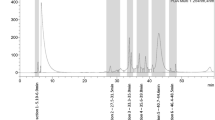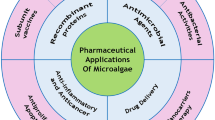Abstract
Extracts from 8 species of marine algae which showed selective cytotoxicity in our previous screening program, were further examined for cytotoxic spectra to five human leukemic cell lines. The extract from a red alga, Amphiroa zonata exhibited strong cytotoxicity to all human leukemic cell lines tested and murine leukemic cells L1210 at the final concentrations from 15 to 375 µg ml−1. Then the cytotoxicity was not found in normal human fibroblast HDF and murine normal cells NIH-3T3. The active extract fraction from this alga was soluble in higher polar organic solvents and water and heat-stable. The extract from a brown alga Dilophus okamurae with weak selective cytotoxic activity to L1210 cells exhibited not only strong cytotoxicity to L1210, but also to human leukemic cells, HL60 and MOLT-4 at 50 µg ml-1. While, the extract from a green alga, Cladophoropsis vaucheriaeformis with most selective cytotoxic activity, did not show cytotoxicity to any human leukemic cell lines tested at 50 µg ml-1. However, this extract showed strong cytotoxicity to two human leukemic cell lines and NIH-3T3 at 100 µg ml−1. Thus, it was considered that a red alga, Amphiroa zonata might be suitable natural source for development of anti-cancer agents without side-effect.
Similar content being viewed by others
References
Cannell JPR (1993) Algae as a source of biologically active products. Pestic Sci 39: 147–153.
Enoki N, Ishida R, Urano S, Ochi M, Tokoroyama T and Matsumoto T (1982) New hydroazulenoid diterpenes from the marine alga Dictyota dichotoma. Chemistry letters 1982: 1837–1840.
Fattorusso E, Maguno S, Mayol L, Santacroce C, Sica D, Amico V, Oriente G, Piattelli M and Tringali C (1976) Dictyol A and B, two novel deterpene alcohols from the brown alga Dictyota dichotoma. J Chem Soc Chem Commun: 575–576.
Finder J, Clardy J, Fenical W, Minale L, Riccio R, Battaile J, Kirkup M and Moore ER (1979) Structures of dictyodial and dictyolactone, unusual marine diterpenoids. J Org Chem 44: 2044–2046.
Furusawa E and Furusawa S (1985) Anticancer activity of a natural product, viva-natural, extracted from Undaria pinnatifida on intraperitoneally implanted Lewis lung carcinoma. Oncology 42: 364–369.
Harada H, Noro T and Kamei Y (1997) Selective antitumor activity in vitro from marine algae from Japan coasts. Biol Pharm Bull 20: 541–546.
Ishitsuka OM, Kusumi T and Kakisawa H (1988) Antitumor xenicane and norxenicane lactones from the brown algae Dictyota dichotoma. J Org Chem 53: 5010–5013.
Kashiwagi M, Mynderse JS, Moode RE and Norton TR (1980) Antineoplastic evaluation of pacific basin marine algae. J Pharm Sci 69: 735–738.
Lincoln AR, Strupinski K and Walker MJ (1991) Bioactive compounds from algae. Life Chem Rep 8: 97–183.
Noda H, Amano H, Arashima K and Nishizawa K (1990) Antitumor activity of marine algae. Hydrobiologia 204/205: 577–584.
Ochi M, Kotsuki H, Muraoka K and Tokoroyama T (1979) The structure of yahazunol, a new sesquiterpene-substituted hydroquinone from the brown seaweed Dictyopteris undurata Okamura. Bull Chem Sci Jpn 52: 629–630.
Ochi M, Watanabe M, Miura I, Taniguchi M and Tokoroyama T (1980) Amijiol, isoamijiol, and 14-deoxyamijiol, three new diterpenoids from the brown seaweed Dictyota linearis. Chemistry Letters 1980: 1229–1232.
Ochi M, Masui N, Kotsuki H, Miura I and Tokoroyama T (1982) The structures of fukurinolal and fukurinal, two new diterpenoids from the brown seaweed Dilophus okamurai Dawson. Chemistry Letters 1982: 1927–1930.
Ohigashi H, Sakai Y, Yamaguchi K, Umezaki I and Koshimizu K (1992) Possible anti-tumor promoting properties of marine algae and in vivo activity of Wakame seaweed extract. Biosci Biotech Biochem 56: 994–995.
Rinehart KL, Jr., Shaw PD, Shield LS, Gloer JB, Harbour GC, Koker MES, Samain D, Schwartz RE, Tymiak AA, Weller DL, Carter GT and Munro MHG (1981) Marine natural products as sources of antiviral, antimicrobial, and antineoplastic agents. Pure and Appl Chem 53: 795–871.
Yamamoto I, Takahasi M, Tamura E and Maruyama H and Mori H (1984) Antitumor activity of edible marine algae: effect of crude fucoidan fractions prepared from edible brown seaweeds against L-1210 leukemia. Hydrobiologia 116/117: 145–148.
Rights and permissions
About this article
Cite this article
Harada, H., Kamei, Y. Selective cytotoxicity of marine algae extracts to several human leukemic cell lines. Cytotechnology 25, 213–219 (1997). https://doi.org/10.1023/A:1007987010840
Issue Date:
DOI: https://doi.org/10.1023/A:1007987010840




